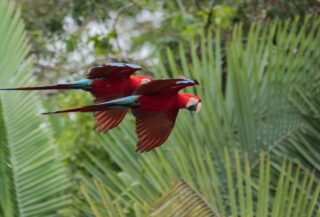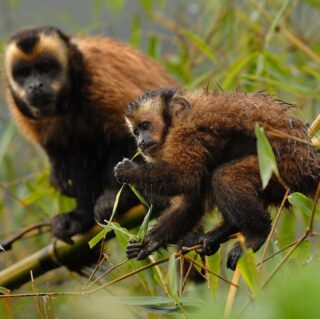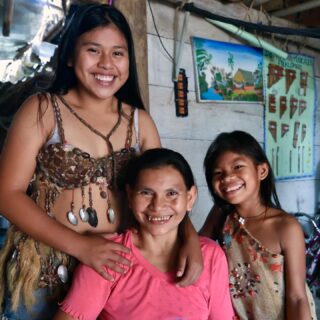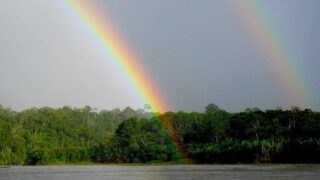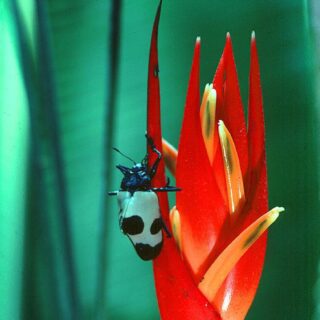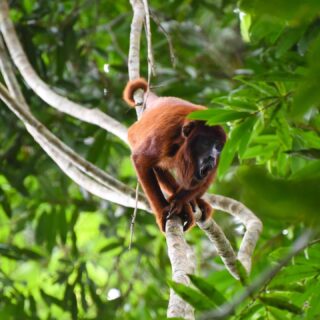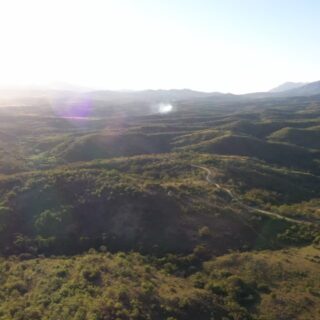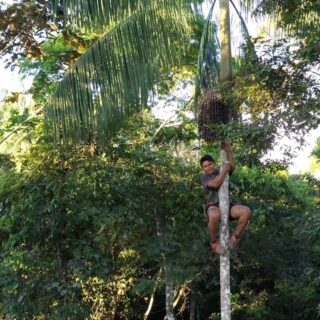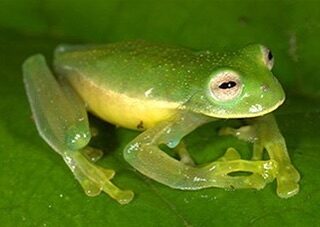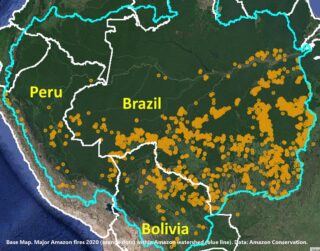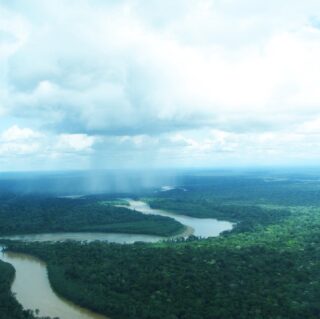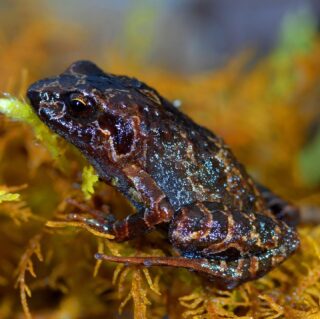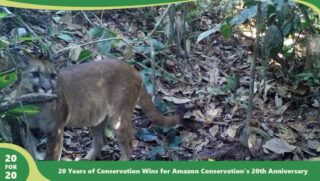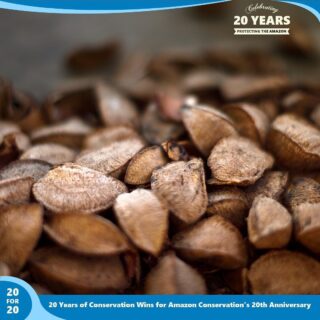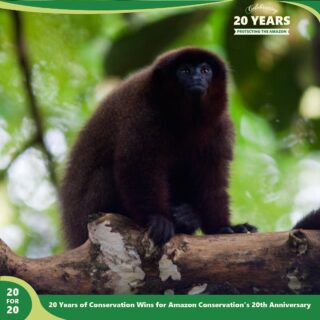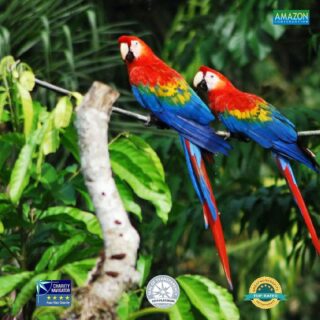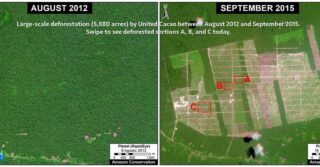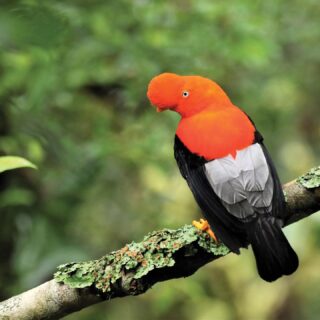 Oxford University professor Yadvinder Malhi has been working at ACA’s Wayqecha Cloud Forest Research Station as the director of the project, “Effects of Climate Change on a Tropical Ecosystem.” As a leader in his field, Malhi is researching the implications of climate change for the cloud forest outside of Cusco, Peru. What follows is our recent interview with Malhi:
Oxford University professor Yadvinder Malhi has been working at ACA’s Wayqecha Cloud Forest Research Station as the director of the project, “Effects of Climate Change on a Tropical Ecosystem.” As a leader in his field, Malhi is researching the implications of climate change for the cloud forest outside of Cusco, Peru. What follows is our recent interview with Malhi:
ACA: What changes might we see on a global scale, due to global warming?
YM: There will likely be many effects. One of these is changes in the distribution of plant and animal species, which may or may not be able to adapt to the changes in climate. In addition, rainfall patterns may be altered; places that have never had droughts might see months without rain–affecting plant, animal and human populations living in those regions. 
ACA: In what way can the Amazon help to limit the effects of global warming?
YM: The Amazon is critical because it limits the effects of climate change. Its forests absorb carbon dioxide and convert it into biomass. Without this, global warming would be greater and more intense. The influence of the Amazon on rain cycles is significant since it ensures that rainwater is retained and returned to the clouds to generate new rainfall. Without the Amazon, water would go directly to the rivers and from there to the ocean and we’d then all have less water available.
ACA: What does your research in the cloud forests of Cusco, Peru involve?
YM: We work closely with the San Antonio Abad University of Cusco (UNSAAC), Oxford University in England, Wake Forest University in the United States and the University of Edinburgh in Scotland. Over the course of four to six years, we are researching the carbon and water cycles in the Amazonian cloud forest, as well as the distribution of plant and animal species and how climate change can affect this distribution. This project is part of a larger one that is studying other types of Amazonian forests at sites in Brazil, Colombia, Bolivia, and northern Peru. We are also using a system of satellite imagery to see the Amazon from space and observe variations in climate across different Amazonian areas.
ACA: What is the importance of ACA’s Wayqecha Cloud Forest Research Center?
YM: Of the two cloud forest research sites, Wayqecha is the best. There are other sites—in Ecuador and other areas of the tropical world, but neither Africa nor Asia has sites like this. That’s why the research we are conducting is not only important to Cusco and Peru, but to all of Latin America and the globe.
ACA: Why is Peru a natural laboratory?
YM: Peru is one of the most vulnerable areas to climate change because of the Andes Mountains, the Amazon and cities like Lima, located in the desert, which need water from the mountains. Without that water source, they would disappear. The Andes are “hot spots” or focal points of global warming. That’s why Peru is a good place to learn about adaptation to climate change; it serves as a natural laboratory because of its sensitivity to global warming.
ACA: When will you finish this project?
YM: It will be another four years; I expect to finish by 2012 with the help of local Peruvian scholars. That’s why we’re training students from Cusco and other regions of Peru, those that are working towards Master’s and Doctoral degrees. We think it is important to train them as this work should be led by Peruvians themselves.
ACA: What is the role of UNSAAC and the Amazon Conservation Association?
 YM: There is a strong collaboration between us; with UNSAAC (Universidad Nacional de San Antonio Abad del Cusco) through students and professors and ACA, which offers a good deal of support through scholarships for Peruvian and foreign students as well as the entire infrastructure of the Wayqecha Research Center in the cloud forest of Cusco and the Los Amigos Research Station (CICRA) in the Amazon rainforest in Madre de Dios – two research centers in strategic areas that are dedicated to comprehensive research and conservation of the Amazon basin in southeastern Peru.
YM: There is a strong collaboration between us; with UNSAAC (Universidad Nacional de San Antonio Abad del Cusco) through students and professors and ACA, which offers a good deal of support through scholarships for Peruvian and foreign students as well as the entire infrastructure of the Wayqecha Research Center in the cloud forest of Cusco and the Los Amigos Research Station (CICRA) in the Amazon rainforest in Madre de Dios – two research centers in strategic areas that are dedicated to comprehensive research and conservation of the Amazon basin in southeastern Peru.
ACA: What can our readers do to help?
YM: We can protect the Amazon, but global action will be important. North America, Europe, China and India and even Latin American countries like Peru have to facilitate studies and research. Thankfully, politicians are already beginning to understand that the greatest danger to the world this century is climate change. I have a lot of hope that decisions and actions will be taken in the next few years. Some countries already encourage limiting carbon dioxide emissions—to be successful, we all need to work together.
 Scientists have described a new species of frog from ACA’s Los Amigos Biological Station (known locally as CICRA). This species, Pristimantis divnae, belongs to the family Strabomantidae and lives in the leaf-litter and understory in terra firme forest at the base of Peru’s southern Andes. The species is characterized by a contrasting pattern of yellow and black with brown patches. The discovery of this new species of Pristimantis is significant because over the last 10 years only eight species from the genus have been found in the Amazon.
Scientists have described a new species of frog from ACA’s Los Amigos Biological Station (known locally as CICRA). This species, Pristimantis divnae, belongs to the family Strabomantidae and lives in the leaf-litter and understory in terra firme forest at the base of Peru’s southern Andes. The species is characterized by a contrasting pattern of yellow and black with brown patches. The discovery of this new species of Pristimantis is significant because over the last 10 years only eight species from the genus have been found in the Amazon. Edgar Lehr from the Senckenberg Natural History Collection in Dresden, Germany and ACA scholarship recipient Rudolf von May from Florida International University’s Department of Biological Sciences describe this new species in the latest issue of the Journal of Herpetology (Vol. 43, No. 3).
Edgar Lehr from the Senckenberg Natural History Collection in Dresden, Germany and ACA scholarship recipient Rudolf von May from Florida International University’s Department of Biological Sciences describe this new species in the latest issue of the Journal of Herpetology (Vol. 43, No. 3).
 On September 7, 2009, ACA/ACCA’s
On September 7, 2009, ACA/ACCA’s  Washington-based Amazon Conservation Association will be featured in the
Washington-based Amazon Conservation Association will be featured in the  iology majors at the Universidad Mayor de San Andrés in La Paz, Bolivia have input productivity and physical data into ACA’s Brazil nut tree database for thousands of Brazil nut trees located in northern Bolivia, near Madidi National Park.
iology majors at the Universidad Mayor de San Andrés in La Paz, Bolivia have input productivity and physical data into ACA’s Brazil nut tree database for thousands of Brazil nut trees located in northern Bolivia, near Madidi National Park. Photos of animals like the ones here were recorded by three camera traps, each just 250 meters from the CICRA biological station in the Los Amigos Conservation Concession in Madre de Dios, Peru.
Photos of animals like the ones here were recorded by three camera traps, each just 250 meters from the CICRA biological station in the Los Amigos Conservation Concession in Madre de Dios, Peru. terrestrial mammal.
terrestrial mammal. (Article by Scott Harris) The Peruvian government reversed course on two controversial laws following a deadly clash earlier this summer between indigenous tribes and police.
(Article by Scott Harris) The Peruvian government reversed course on two controversial laws following a deadly clash earlier this summer between indigenous tribes and police. The Madre de Dios region was not directly affected by the protests or the decrees, although it could have been eventually impacted by the precedents set by the decrees had they remained in place. Madre de Dios president Santos Kaway will be a member of the government’s new Amazonian Peoples group, along with four representatives of the government’s executive branch, the presidents of Peru’s Loreto, Ucayali, Amazonas, and San Martin regions, and 10 representatives of Amazonian native communities.
The Madre de Dios region was not directly affected by the protests or the decrees, although it could have been eventually impacted by the precedents set by the decrees had they remained in place. Madre de Dios president Santos Kaway will be a member of the government’s new Amazonian Peoples group, along with four representatives of the government’s executive branch, the presidents of Peru’s Loreto, Ucayali, Amazonas, and San Martin regions, and 10 representatives of Amazonian native communities. ACA and our Peruvian sister organization, ACCA, hosted an international conference on REDD (Reducing Emissions from Deforestation and Forest Degradation) from May 4-6, 2009, in Madre de Dios, Peru. A market-based strategy for mitigating climate change, REDD offers carbon buyers a way to “offset” their greenhouse gas emissions and sellers to earn a profit from protecting their forests. Co-hosted by the Regional Government of Madre de Dios (GOREMAD), the conference addressed economic, social, and environmental opportunities and challenges for REDD in Madre de Dios and the rest of the MAP Region (Madre de Dios, Peru; Acre, Brazil; Pando, Bolivia).
ACA and our Peruvian sister organization, ACCA, hosted an international conference on REDD (Reducing Emissions from Deforestation and Forest Degradation) from May 4-6, 2009, in Madre de Dios, Peru. A market-based strategy for mitigating climate change, REDD offers carbon buyers a way to “offset” their greenhouse gas emissions and sellers to earn a profit from protecting their forests. Co-hosted by the Regional Government of Madre de Dios (GOREMAD), the conference addressed economic, social, and environmental opportunities and challenges for REDD in Madre de Dios and the rest of the MAP Region (Madre de Dios, Peru; Acre, Brazil; Pando, Bolivia). nizations and other civil society groups, and students from Universidad Nacional Amazónica de Madre de Dios (UNAMAD). The event was also broadcast in real time via closed-circuit TV with local and regional press in attendance.
nizations and other civil society groups, and students from Universidad Nacional Amazónica de Madre de Dios (UNAMAD). The event was also broadcast in real time via closed-circuit TV with local and regional press in attendance. The Amazon Conservation Association, our Peruvian sister organization,
The Amazon Conservation Association, our Peruvian sister organization,  extraordinary plant life. Other bridges lead visitors across forested slopes that cover eight distinct eco-zones, providing a view from more than 10,000 feet in elevation down to the Amazon basin.
extraordinary plant life. Other bridges lead visitors across forested slopes that cover eight distinct eco-zones, providing a view from more than 10,000 feet in elevation down to the Amazon basin. Oxford University professor Yadvinder Malhi has been working at ACA’s
Oxford University professor Yadvinder Malhi has been working at ACA’s 
 YM: There is a strong collaboration between us; with UNSAAC (Universidad Nacional de San Antonio Abad del Cusco) through students and professors and ACA, which offers a good deal of support through scholarships for Peruvian and foreign students as well as the entire infrastructure of the
YM: There is a strong collaboration between us; with UNSAAC (Universidad Nacional de San Antonio Abad del Cusco) through students and professors and ACA, which offers a good deal of support through scholarships for Peruvian and foreign students as well as the entire infrastructure of the  We are happy to welcome Dr. Adrian Tejedor as our new Science Manager based at
We are happy to welcome Dr. Adrian Tejedor as our new Science Manager based at